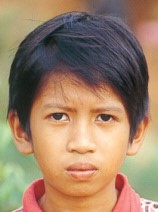Dayak, Dohoi Ot Danum in Indonesia

Photo Source:
Copyrighted © 2026
Anonymous All rights reserved. Used with permission |
Send Joshua Project a map of this people group.
|
| People Name: | Dayak, Dohoi Ot Danum |
| Country: | Indonesia |
| 10/40 Window: | Yes |
| Population: | 98,000 |
| World Population: | 98,000 |
| Primary Language: | Ot Danum |
| Primary Religion: | Ethnic Religions |
| Christian Adherents: | 14.00 % |
| Evangelicals: | 9.00 % |
| Scripture: | New Testament |
| Ministry Resources: | Yes |
| Jesus Film: | Yes |
| Audio Recordings: | Yes |
| People Cluster: | Barito of Kalimantan |
| Affinity Bloc: | Malay Peoples |
| Progress Level: |
|
Introduction / History
The Dohoi Ot Danum live in Central Kalimantan. There are four branches of the Dohoi people, who live in a 300 km long area that is spread out from the source of the Melawi River to the source of the Barito River. The Dohoi are one of the people groups in the Barito cluster which is part of the larger Dayak ethno-linguistic cluster. Ot Danum is a generic term meaning "people who live in the upper regions along rivers." It covers a number of peoples who share a common myth of origin and who speak closely related dialects of the same language. The Dohoi Ot Danum have their own story about their origin. They believe that long ago two brothers and two sisters descended from the sky on top of a golden palangka (place of worship). The brothers traveled along the Kahayan River and the sisters along the Barito River. One day while hunting, the brothers saw some human footprints and began to follow them. The footprints lead them to the two sisters, and later they were married. One of the couples returned to Kahayan, and their descendants later became known as the Dohoi people.
What Are Their Lives Like?
The Dohoi Ot Danum Dayak are primarily rice farmers who also gather products from the forest such as resin, rubber, ironwood, and animal skins. Loin cloths are often worn for informal events while wrap-around skirts are worn on formal occasions. Dogs, pigs, and chickens are raised as domestic animals, and oxen are raised to be eaten for special celebrations. Water buffalo are kept separate from the village, because they can quickly become wild and endanger the inhabitants of the village. The Dohoi are well known as makers of woven hats, baskets, and floor mats. They make their own farming and hunting tools. The number of inhabitants in a village can range from 100 to 400 people. Their homes are square shaped and stand on wooden poles about 6-10 feet above the ground. The land around the village, up to 3-kilometers in radius, is considered village property. Every villager has the right to sell his land at any time but only to another villager. If land has not been planted for more than 5 years, another villager can claim it. Neighborhood relationships are different from one group to another. The best relationships occur between groups with the same dialect. Marriage between cousins is preferred among the Dohoi Ot Danum. When a marriage has been agreed upon between the parents of the engaged couple, the future groom's family will give a symbolic gift to the future bride's family. A second gift is given when the engagement is announced. Wedding gold is given after the wedding day.
What Are Their Beliefs?
The Dohoi Ot Danum are animists and polytheists. Their two most important gods take the form of a hornbill bird and a water snake. The Dohoi Ot Danum often perform various ceremonies. They depend on a dukun (shaman/healer/occultist) for healing when they are sick.
What Are Their Needs?
In times past the Dohoi Ot Danum lost much of their land as a result of attacks by neighboring headhunter tribes. In more recent times, the neighboring government of Malaysia has mistreated them. Today, some of the Dohoi still have a "slave complex" as a result of this long history of exploitation.
Prayer Points
Pray for hundreds of Dohoi Ot Danum Dayak to be blessed with an unwavering faith in Christ, one that will not be shaken, no matter what comes their way.
Pray for God to bring about his purpose for the Dohoi Ot Danum Dayak people.
Pray for Christians to have love, joy, peace, and patience as they tell others about the King of kings.
Pray for a mighty Holy Spirit revival to permeate their families and churches, drawing them into greater love for God and for their neighbors.